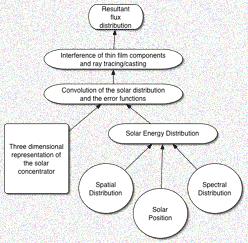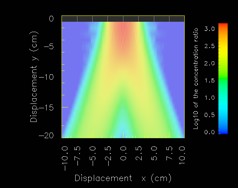 |
The Solar Energy Group @ |
| Home Contact |
|
|
Research @ the Solar Energy GroupOptical ModellingThe key issues in designing homogenous fluxes in the absorber plane and understanding the thermal load on absorbers is to have an accurate representation of the solar flux impinging on the surface. At the University of Sydney we have created a modelling framework to simulate the flux distribution in dynamic abstract solar concentrators [1]. The model is designed to optimise the optics and hence designs of solar power systems. The model consists of a series of libraries (Figure 1) written in the computer language c++ with four main components: the PSA Algorithm [2] for calculating the solar vector, SPECTRAL2 [3] simulating the spectral energy distribution and two new computer codes that describe the spatial energy distribution of the solar image [4] and the broadening that occurs when a solar image is reflected off a non-ideal mirrored surface. The model uses the principle of ray tracing to recreate the flux distributions, and the results have a high correlation to observed data. By recreating the geometrical design of the optics in any concentrating system, including the systemic errors in tracking, surface and alignment, the solar energy distribution can be traced about the imaging plane to give an accurate representation of that flux. The model is a three-dimensional representation of the flux of which an example cross-section can be seen in Figure 2.
To complement this model a range of thin-film simulations have been created to identify the performance of spectral beam splitters and selective surfaces on both PV and thermal absorber. The results of these simulations are optical models that can represent real concentrating systems in spatial and spectral flux that have a high correlation to observed data. The models have been used in a number of publications [5-10] Bibliography[1] Buie D. and Imenes A.G., "A solar vector class for the optical simulation of solar concentrating systems", in: Proc. ISES Solar World Congress, 14-19 June 2003, Gothenburg, Sweden. [2] Blanco-Muriel, et al. Computing the solar vector, Solar Energy 70 (2002) pp. 431-441. [3] Bird, R. E., Riordan, C., Solar spectral model for direct and diffuse irradiance of horizontal and tilted planes at the earth's surface for cloudless atmosphere, Journal of Climate and Applied Meteorology 25(1986), pp. 87-97. [4] Buie, D. et al., Sunshape distributions for terrestrial solar simulations, Solar Energy 74(2003) pp. 113 - 122. [5] Buie D., et al., Full day simulations of antireflection coatings on silicon photovoltaics, Solar Energy Materials and Solar Cells 81(2004), 13-24. [6] Imenes et al., A new strategy for improved spectral performance in solar power plants. In Press. Solar Energy. [7] Imenes A.G. and McKenzie D., Flat-topped broadband rugate filters. Submitted to Applied Optics, Feb. 2005. [8] Buie D. and Imenes A.G., Angular characterisation of the solar flux in central receiver systems. Submitted to Solar Energy. [9] D. Mills, et al., Beam Splitter for Solar Towers and Dish Collectors”. Patent application prepared in 2004, provisional patent application #5006. [10] D. Mills et al., Surface for uniform illumination”. Patent application prepared in 2004, provisional patent application #5004. |

